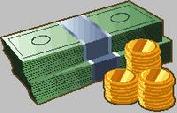
 |
|
| Financial Terms | |
| Move |
|
Information about financial, finance, business, accounting, payroll, inventory, investment, money, inventory control, stock trading, financial advisor, tax advisor, credit.
Main Page: inventory control, financial, accounting, investment, payroll, stock trading, inventory, financial advisor, Also see related: buy home, financing, real estate, property, home, insurance, first time homebuyer, homes, home buyer, |
Definition of Move
MoveThe movement of inventory among various locations within a company.
Related Terms:CARs (cumulative abnormal returns)a measure used in academic finance articles to measure the excess returns an investor would have received over a particular time period if he or she were invested in a particular stock. Abnormal returnsPart of the return that is not due to systematic influences (market wide influences). In Beta (Mutual Funds)The measure of a fund's or stocks risk in relation to the market. A beta of 0.7 means Book-entry securitiesThe Treasury and federal agencies are moving to a book-entry system in which securities are not represented by engraved pieces of paper but are maintained in computerized records at the BreakoutA rise in a security's price above a resistance level (commonly its previous high price) or drop Bubble theorySecurity prices sometimes move wildly above their true values. Common marketAn agreement between two or more countries that permits the free movement of capital  Concentration servicesmovement of cash from different lockbox locations into a single concentration ConvergenceThe movement of the price of a futures contract toward the price of the underlying cash CovarianceA statistical measure of the degree to which random variables move together. Covered or hedge option strategiesStrategies that involve a position in an option as well as a position in the Dead cat bounceA small upmove in a bear market. DefeasancePractice whereby the borrower sets aside cash or bonds sufficient to service the borrower's debt. DetrendTo remove the general drift, tendency or bent of a set of statistical data as related to time. Economic unionAn agreement between two or more countries that allows the free movement of capital, Exposure nettingOffsetting exposures in one currency with exposures in the same or another currency,  Flight to qualityThe tendency of investors to move towards safer, government bonds during periods of high Foreign exchange riskThe risk that a long or short position in a foreign currency might have to be closed out Fund familySet of funds with different investment objectives offered by one management company. In many Hot moneyMoney that moves across country borders in response to interest rate differences and that moves In-substance defeasanceDefeasance whereby debt is removed from the balance sheet but not cancelled. Margin callA demand for additional funds because of adverse price movement. Maintenance margin Market timing costsCosts that arise from price movement of the stock during the time of the transaction Minimum price fluctuationSmallest increment of price movement possible in trading a given contract. Also Negative durationA situation in which the price of the MBS moves in the same direction as interest rates. Open repoA repo with no definite term. The agreement is made on a day-to-day basis and either the Overbought/oversold indicatorAn indicator that attempts to define when prices have moved too far and too Overreaction hypothesisThe supposition that investors overreact to unanticipated news, resulting in PivotPrice level established as being significant by market's failure to penetrate or as being significant when Rally (recovery)An upward movement of prices. Opposite of reaction. Relative strengthA stock's price movement over the past year as compared to a market index (the S&P 500). RetracementA price movement in the opposite direction of the previous trend. TradersPersons who take positions in securities and their derivatives with the objective of making profits. Cash Flow statementA financial report that shows the movement in cash for a business during an accounting period. Economic Value Added (EVA)Operating profit, adjusted to remove distortions caused by certain accounting rules, less a charge global economyan economy characterized by the international Binomial modelA method of pricing options or other equity derivatives in CovarianceA measure of the degree to which returns on two assets move in Point and figure chartA financial chart usually used to plot asset price data. National IncomeGDP with some adjustments to remove items that do not make it into anyone's hands as income, such as indirect taxes and depreciation. Loosely speaking, it is interpreted as being equal to GDP. 401k PlanA retirement plan set up by an employer, into which employees can Net PayThe amount of an employeeâs wages payable after all tax and other deductions have been removed. Adjusted Cash Flow Provided by Continuing OperationsCash flow provided by operating Adjusted Income from ContinuingOperations Reported income from continuing operations EBBS - Earnings before the bad stuffAn acronym attributed to a member of the Securities and Income SmoothingA form of earnings management designed to remove peaks and valleys Present ValueThe amount due on an obligation less any interest on that obligation that would Restatement of Prior-Year Financial StatementsA recasting of prior-year financial statements to remove the effects of an error or other adjustment and report them on a new basis. Recurring EBITDAThe standard EBITDA with the effects of nonrecurring items removed. Sustainable EarningsReported earnings that have had the after-tax effects of all material Bin transferA transaction to move inventory from one storage bin to another. Interplant transferThe movement of inventory from one company location to Parts requisitionAn authorization to move a specific quantity of an item from Picking listA document listing items to be removed from stock, either for delivery to the shop floor for production purposes or for delivery to a customer. Standard containersCommon-sized containers that are used to efficiently move, Beta coefficientA measurement of the extent to which the returns on a given stock move with stock market. Related to : financial, finance, business, accounting, payroll, inventory, investment, money, inventory control, stock trading, financial advisor, tax advisor, credit. |